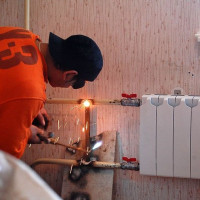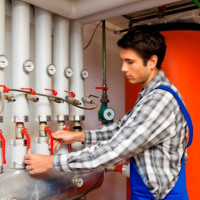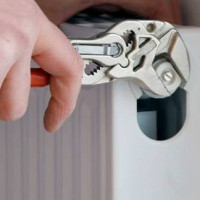Economical heating of a private house: choosing the most economical heating system
Almost every owner of the cottage seeks to minimize the cost of heating it. But choosing the most economical heating of a private house, many often look only at the price of fuel.
However, here it is necessary to take into account both the heat loss of the building, and the capital investment in the arrangement of the heating system, and the cost of maintaining the network subsequently. Do not forget about the complexity of the operation of a particular option. Only an integrated approach to the issue will help make the operation of the heat supply network as economical as possible, agree?
In the article, we have collected the most effective ways to increase the efficiency of the heating system, provided practical advice on reducing heat loss, and also evaluated the feasibility of using renewable energy sources.
The content of the article:
First and foremost, reducing heat loss
Before choosing a fuel, a boiler (or another generator of thermal energy) and a heat distribution system for a cottage, you need to look at the house itself. If heat losses through walls, windows, ventilation, floor and roof are huge, then no tricks to improve the efficiency of the internal heating circuit will help.
First you need to take care of the insulation of all structures and engineering systems of the home.

With a high level of heat loss, any attempts to increase the efficiency of the heating system will turn out to be meaningless, all the same, most of the heat will go to the street. And it will be required a lot. The enclosed space of the cottage is one thing, and the street open to winds and bad weather is quite another.
Technology and insulation materials are selected based on the climatic conditions of the area where the house is. There are certain building standards with minimum requirements for wall thickness and thermal insulation for each Russian region.But without knowledge in heat engineering, you should not do the project yourself.
Either the calculations will be made incorrectly and the heat loss will be higher, or you will have to overpay for a too thick insulation layer.
When viewing the finished project and the subsequent construction of the house, special attention should be paid to:
- double glazing - up to 25% of all heat losses go through the windows to the street;
- roof and attic floor - this is another 10-15%;
- ventilation system - the proportion of heat loss through ventilation with natural circulation can reach 40-50%.
Walls and floors are also places where heat exits the building. But no one neglects their warming initially. But about ventilation, ceiling insulation and the attic, many owners of private homes are often forgotten.
Another point is the presence of "cold bridges" in the building envelope. Any iron part penetrating the wall through the street inward serves as a place of enormous heat loss.
Even a small pin made of metal, albeit slowly, but inexorably, “draws” heat from the housing. The project should not have such bridges, and during construction it is important to ensure that they do not form from various metal fasteners.

In addition, cold bridges can include:
- ends of floor slabs;
- window and door slopes;
- basement walls;
- jumpers and inserts made of concrete or iron.
All these places must be carefully insulated, otherwise you can not even dream of saving on heating. Nobody has ever succeeded in warming the street.
Depending on the quality of insulation, the coefficient of thermal conductivity appearing in the heat engineering calculation for one building can differ significantly. The thicker the insulation and the less points of heat “leakage”, the smaller the amount of fuel you have to burn after to heat the cottage.
The money spent on reducing heat loss will pay off necessarily. You should not skimp on this issue, but you should not forget about the reasonableness of investments.
Choosing the cheapest fuel
The second issue in saving on heating is type of fuel used. Moreover, one should look not so much at the cost of calories at the outlet of the boiler, but at the total costs of fuel, heating equipment and its maintenance. It is necessary to consider everything in a complex.

If you compare different water-heating units, then the cheapest will be electric boilers. However, electricity bills are unlikely to please anyone later. Plus, for a large cottage in most cases, you will have to lay an additional cable.
For a well-insulated house of 100 squares of existing capacity, maybe enough. But for heating a two-story dwelling electric “fuel” will require much more. At the same time, standard networks were not initially designed for such loads.
Natural gas in Russia is considered one of the most economical ways to heat private homes. However, there are several nuances. If there is already a highway in the village, then gas connection happens fast enough and inexpensively.
But if the distance from the house to it is 200 m or more, then the insert in this pipe will cost a pretty penny. Plus, all approval and receipt of technical conditions can take up to a year.
Behind gas tank installation and the equipment for it will have to be laid out from 150 to 250 thousand rubles. Fortunately, most of the companies involved in such equipment do all the work in a couple of days.
For him, liquefied gas is ultimately priced in almost all Russian regions with what comes from the main pipe.But here the initial costs openly bite.
Another reasonably cheap boiler is one that runs on mining or diesel. Moreover, if the fuel can be obtained at a reasonable price, then similar liquid fuel boiler equipment may well be the most economical way to heat private housing.
Russia's heating options for a country house averaged over the totality of all costs are located in the following order:
- Stove on wood or charcoal.
- Gas boiler for main gas.
- Wood burning pellet boiler.
- Liquid fuel boiler equipment.
- Electric boiler.
The most economical option is a conventional wood or coal stove, provided it is true that there is no problem with fuel in the area of residence. It affects the cheapness of fuel, and the cheapness of equipment.
However, such a furnace requires constant supervision. And it takes a lot of time and effort. Plus, it is hardly possible to increase the efficiency of the heating system connected to it. It is difficult to adjust or somehow control the economical consumption of logs (coal).

The most convenient and safe in operation is an electric boiler. He does not need a chimney, plus the automation itself monitors everything and, as necessary, heats the coolant in the system.
With proper wiring, the likelihood of a fire with this method of heating is reduced to almost zero. He certainly should not present other problems.
However, the cost of electricity is frankly high. It’s good if you can connect a two-rate meter with a reduced night rate. Otherwise, stopping your choice on an electric boiler is only a last resort. It is difficult to call it the most “economical” due to the high cost of “burned” kilowatts of electricity.
Improving the efficiency of the heating system
To increase the cost-effectiveness of heating a house, it is also possible and necessary to introduce various technologies that reduce fuel consumption into the heating system. There are a huge number of ways to lay pipelines from the boiler to radiators.
Some of them are cheaper to implement, while others are the most economical in terms of reducing losses during transportation of the coolant to the batteries.

There are heating equipment of various designs and various additional equipment that can increase the efficiency of the entire system by 10-15% or more. But here you should carefully weigh the pros and cons. In some cases, the costs at the initial stage may not pay off subsequently.
Do not chase the "most economical" and "most effective" options. Often these are simply advertising slogans and nothing more.
Method # 1: pipe routing and underfloor heating
The most economical piping scheme is heating radial distribution with central manifold. In its application, each radiator receives the same amount of coolant.
Moreover, it is possible for each battery to adjust the amount of heat supplied individually. Excessive waste of thermal energy when transporting heated water through heating pipes with such a wiring is practically eliminated.

Almost always with collector wiring, the heating system has to be supplemented circulation pump. Thanks to him, the temperature difference of the water at the inlet and outlet of the network is significantly reduced.
As a result, the adjustable heat carrier heating and the efficiency of the entire system are increased. The fuel in the boiler has to be burned less, the result - direct fuel savings.
The beam (collector) option is the most economical to operate. However, due to the large length of the pipelines, it is also the most expensive to implement.

The heat from ordinary batteries first rises to the ceiling, and only then, due to convection, it spreads throughout the room. As a result, the hottest air is under the ceiling. And so that your feet in the cold outside the window do not freeze on the floor, you have to open the radiators to the full. And this is again the additional cost of heat generation.
System water "warm floor" - The most economical way to heat residential premises. In this case, the warmest air is concentrated below at the level of the person’s legs. At the same time, heat consumption is reduced, and the room creates the most comfortable conditions for people.
Method # 2: the most efficient boilers
The highest efficiency of pyrolysis and condensation boilers. It is difficult to find more economical heating equipment in the stores of heat engineering. The first option uses firewood as fuel, and the second uses gas. In terms of efficiency, they overtake all other analogues on any combustible coolant.
The pyrolysis boiler differs from a conventional wood boiler by the presence of a second firebox and by the fact that in fact there is not wood burning as such, but the gas obtained as a result of pyrolysis.
First, logs smolder in it at high temperature and limited air intake. And only then the gases already obtained as a result of this are burned in the main chamber with the release of heat.
Compared to a standard wood counterpart pyrolysis boiler It has a higher efficiency (30–40%) and requires less attention to itself. The interval between firewood downloads, depending on the capacity of the furnace, reaches 10–16 hours.
The savings here are due to the absolutely complete combustion of the fuel and the minimum heat output from the combustion products into the chimney.

Taking into account the collection of additional heat, the final efficiency of such a boiler reaches 105–110%. This takes into account the energy of both the burnt gas and that obtained as a result of the condensation of water vapor in the second chamber.
Method # 3: select a heat accumulator
Another fairly effective way to save on heating is to connect a heat accumulator to the solid fuel boiler. The latter first accumulates heat in itself, and then gradually gives it to the batteries.
In this case, it is not necessary to forcibly limit the power of the heating medium heating equipment, simply emitting heat into the chimney pipe.

If electricity is supplied to the cottage at different rates day and night, then the heat accumulator can be included in the system with an electric boiler. In this case, it will accumulate heat at night, when electricity is cheaper.
Renewable heat sources
In a detailed cost calculation with heat pumps, windmills, solar collectors and batteries, the situation is as follows. They generate heat and electricity for a private house only at first glance, free of charge. Of course, the sun and wind do not issue bills for heating, however, such equipment for generation is very expensive.
It is in Europe that renewable energy is subsidized in some places from the state budget. Plus, the price tag for fossil fuels bites them frankly.Therefore, there, “green technologies” are economically viable and relatively effective.
In Russia, the situation is radically different. We have a state subsidy alternative energy not going yet. And the prices for domestic firewood, coal and gas, in comparison with the neighbors in the west, are not so high.
As a result, for the totality of all costs, heat pumps, solar panels and windmills are hardly economical in our country. They mainly show their effectiveness only in remote areas where it is difficult and expensive to import combustible fuel.
Conclusions and useful video on the topic
Choosing the most economical heating option for your cottage, you should consider many factors and parameters, and the following selection of video materials will definitely help you with this.
Which heating is better:
What is the cheapest fuel to heat a country house:
How much does gas and electric heating cost:
There is no universal option for the cheapest and most economical heating. For each particular house, it is necessary to calculate all the costs of fuel, equipment for heating the coolant and the arrangement of the heating system as a whole.
Often it is necessary to build on the availability of a particular fuel, and only then select a boiler for it. Plus categorically do not forget about the quality insulation of the cottage and pipes to radiators.
Share with your readers your experience of improving the efficiency of the heating system. Please leave comments on the article and ask your questions. The feedback form is located below.

 Types of heating systems for a private house: a comparative overview + the pros and cons of each type
Types of heating systems for a private house: a comparative overview + the pros and cons of each type  Do-it-yourself economical garage heating: how to reduce heat loss and the better it is heated
Do-it-yourself economical garage heating: how to reduce heat loss and the better it is heated  Individual heating in the apartment: the best options for an apartment building
Individual heating in the apartment: the best options for an apartment building  Energy-saving heating systems: how and what can be saved?
Energy-saving heating systems: how and what can be saved?  Removing air from the heating system: how to bleed air
Removing air from the heating system: how to bleed air  Distribution comb of the heating system: purpose, principle of operation, connection rules
Distribution comb of the heating system: purpose, principle of operation, connection rules  How much does it cost to connect gas to a private house: the price of organizing gas supply
How much does it cost to connect gas to a private house: the price of organizing gas supply  The best washing machines with dryer: model rating and customer tips
The best washing machines with dryer: model rating and customer tips  What is the color temperature of light and the nuances of choosing the temperature of the lamps to suit your needs
What is the color temperature of light and the nuances of choosing the temperature of the lamps to suit your needs  Replacement of a geyser in an apartment: replacement paperwork + basic norms and requirements
Replacement of a geyser in an apartment: replacement paperwork + basic norms and requirements
And we, in order to save money, use three types of heating in our house. The main one is a water radiator system with a gas boiler. Each room has electric convectors. We turn them on only at night, and reduce the heating of water by gas to a minimum. At night, our electricity tariff is cheap, according to a two-tariff meter. Initially, the house had stove heating, and then connected to a centralized gas supply. We saved the rough stove, now in severe frosts we drown it with firewood. It also helps to save. The most comfortable and pleasant warmth comes from her.